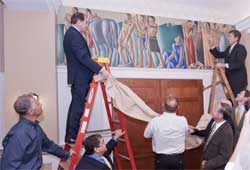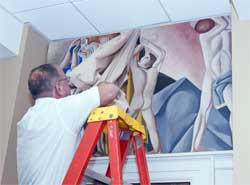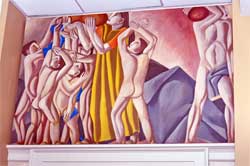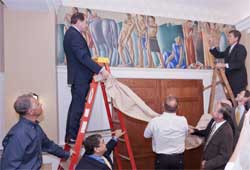 KINGSTON, R.I. – October 3, 2011 – Depression-era murals by Rhode Island artist Gino Conti, once thought to be lost or painted over, are now back home and on public view at Edwards Hall at the University of Rhode Island.
KINGSTON, R.I. – October 3, 2011 – Depression-era murals by Rhode Island artist Gino Conti, once thought to be lost or painted over, are now back home and on public view at Edwards Hall at the University of Rhode Island.
The murals, which were covered by a 1960s remodeling project, were discovered while workers removed sheetrock in Edwards to prepare for renovation work in the summer of 2010.
The University community celebrated the restoration of the murals with a public unveiling today in the lobby of Edwards Hall, which houses a 900-seat auditorium for many of the University’s most prominent public events. The celebration also marked the completion of a $1.5 million project to enhance fire protection, technology and aesthetics in one of URI’s classic granite structures, which opened in 1928.
Last year’s project was funded by the American Recovery and Reinvestment Act, a federal initiative to stimulate job creation during the recession. The construction work uncovered the artwork created under a similar federal program that responded to America’s Great Depression, which began in the late 1920s and continued until World War II. The federal Works Progress Administration (WPA), which was designed to provide jobs and boost the economy during the 1930s and 1940s, funded Conti’s original installation.
After the murals were uncovered in July 2010, URI hired the Williamstown Art Conservation Center in Williamstown, Mass. to remove and restore the canvasses.
The restoration work was completed this past summer, and the murals returned to the University about a week ago.
“Today we celebrate the return of historic artifacts that remind us of the difficulties and triumphs of a most challenging time in the nation’s history,” said URI President David M. Dooley. “How fortunate we are at URI to have discovered a part of our heritage we thought was lost and now be able to return the artwork to its original space in Edwards Hall for all to enjoy. This artwork, commissioned at a time when our country had to come together to solve overwhelming problems, reminds us that unity of purpose and respect for all are the keys to solving the sometimes daunting problems of today.”
The murals project received primary support from the Division of Administration and Finance. Robert A. Weygand, the division’s vice president, commended Dan Lonergan, a property and control officer at the University, Paul DePace, director of Capital Projects, Tom Frisbie-Fulton, director of Campus Planning and Design, Mary Brennan, now the campus recycling coordinator, David Maslyn, dean of University Libraries, Peter Conti (no relation to artist), of Calson Construction Corp. of Johnston and Peter Scalora, the project manager from Gilbane Building Co., for their central roles in discovering and protecting the artwork for preservation.
“This was an extraordinary example of the teamwork that exists on this campus,” Weygand said. “We are fortunate to have URI staff members and our private construction partners who saw the value of preserving this treasure, even if it meant a dramatic interruption in the work on Edwards. We are deeply indebted to all who worked on this project, and we are pleased to be able to present this wonderful art to the public for the first time since the 1960s.”
Thomas Branchick, director and conservator of paintings at the Williamstown center, explained the restoration process.
“Our biggest concern was what to do about the adhesive residue on the back of the paintings,” Branchick said. “One option was to remove the residue with a scalpel, but that would have been impractical and time consuming.”
So Branchick and his team decided to place the murals face down on a solid, flat surface and apply heat and pressure.
“So now the residue is in the reverse of the painting,” Branchick said. “Now the paintings are in perfect plane.”
The murals were then mounted to adjustable, wooden framework for artwork known as stretchers. After cleaning the paint surface, Branchick began painting missing or damaged sections of the murals.
“This was filling in the losses with acrylic paint,” Branchick said. “This is very fine work. You don’t want to over paint, you are just trying to fill in the losses.”
The final step was applying a protective layer of varnish with a matte finish. “They look great, and I am thinking Mr. Conti was giving us his blessing,” Branchick said.
URI Professor Ron Onorato, an art historian who wrote a paper in the early 1980s titled, Rhode Island’s WPA Art, has been awaiting today’s event.
 “I was thrilled with the discovery last year, but I am even happier to see them in excellent condition hanging in one of our public venues for everyone to enjoy,” Onorato said. “This artwork is not only from an era of national significance, but is also of state significance, since Mr. Conti was a well-known Rhode Island and regional artist who came to this country from Italy with his parents. What a great opportunity for our students to be able to learn about and see relics from the nation’s past.”
“I was thrilled with the discovery last year, but I am even happier to see them in excellent condition hanging in one of our public venues for everyone to enjoy,” Onorato said. “This artwork is not only from an era of national significance, but is also of state significance, since Mr. Conti was a well-known Rhode Island and regional artist who came to this country from Italy with his parents. What a great opportunity for our students to be able to learn about and see relics from the nation’s past.”
Onorato’s paper addressed the history of many works of art from the WPA era, in which he pointed out that many projects, “like the projects for Edwards Hall… have been painted out, destroyed or otherwise lost.”
In discussing what could be a new chapter in what was thought to be a story of lost treasure, Onorato said that Conti’s work on the Edwards’ murals depict allegorical scenes having to do with progress, education, and larger concepts.
“The murals are classically inspired,” Onorato said. “(Conti) was looking at European work; he went to Europe a number of times, and also examined the famous Mexican muralists in the 1930s. These murals are about values.”
According to the March 16, 1941 Providence Journal, “Of the two largest panels, one symbolizes the drama, music and the dance; the other the protection of youth; the striving for progress and the past. Four smaller canvasses depict the elements with groups of figures symbolizing water, fire, air and workers in the soil.”
Pictured above
BEHIND CURTAIN NUMBER ONE: URI President David M. Dooley, left, Robert A. Weygand, vice president for administration and finance, unveil one of the restored Gino Conti murals in Edwards Hall.
DOING HIS PART: Dan Lonergan, a property and control officer at URI, who played a key role in making sure the Gino Conti murals were protected when they discovered in the summer of 2010, reveals one of the murals.
RESTORED TREASURE: A look at one of the murals by Gino Conti in the lobby of Edwards Hall.
URI Department of Communications & Marketing photos by Michael Salerno Photography.

